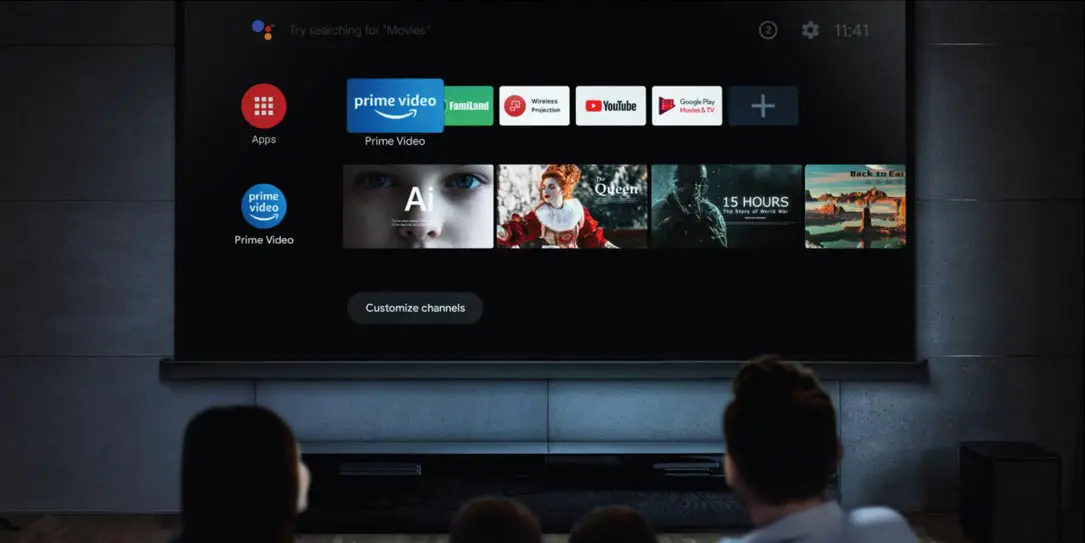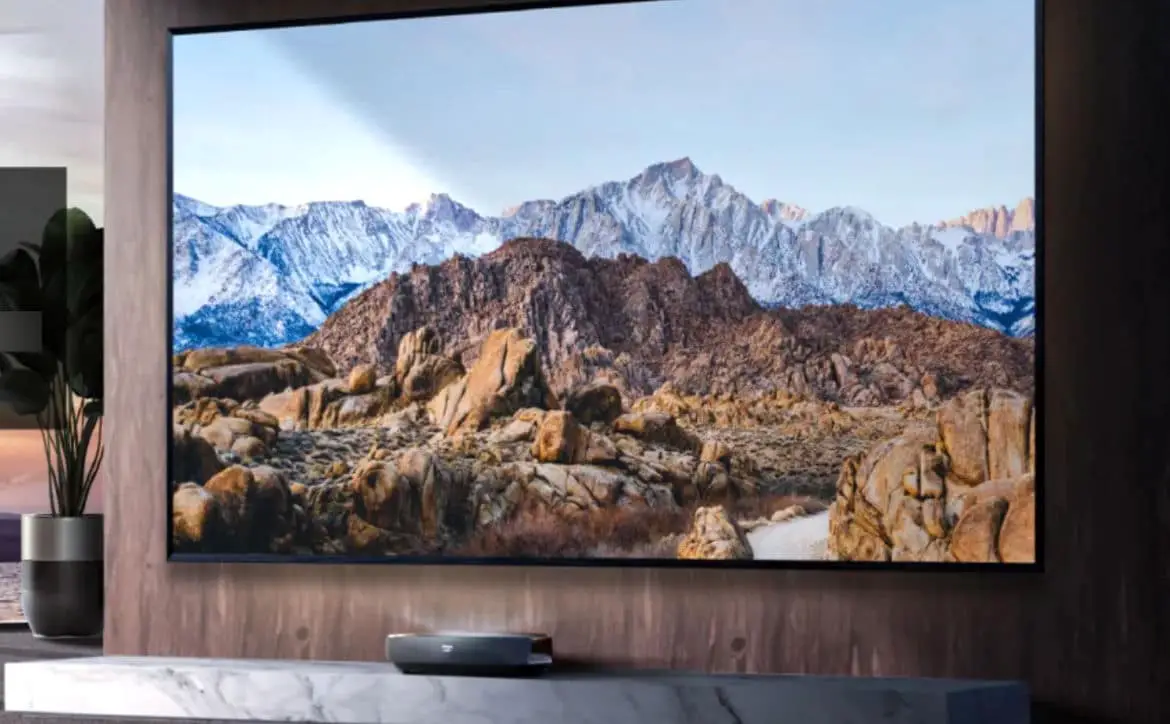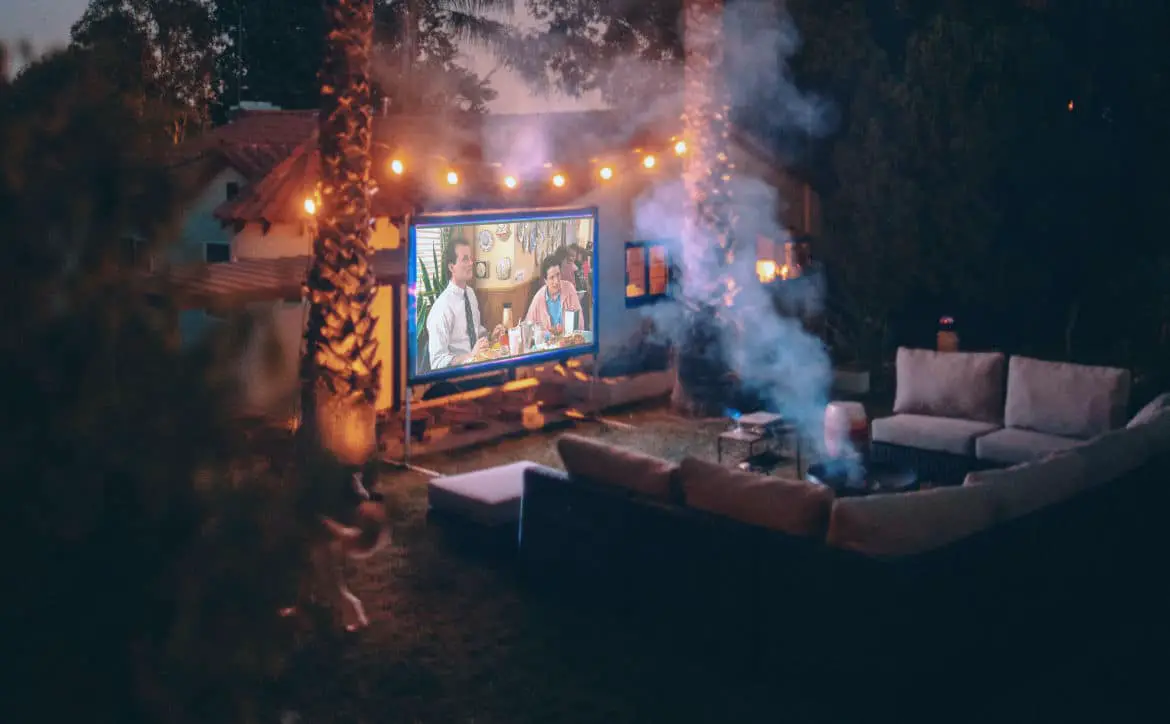Home theater projectors are becoming more and more popular by the minute. More cost-effective and versatile than any giant tv over 90 inches, it’s no wonder the tide of large-scale home entertainment is changing.
Estimated reading time: 8 minutes
Gone are the problems of the primitive home projector screens, which suffered from issues ranging from screen brightness to viewing angle and overall image quality. Mostly they were an afterthought in an at-home projection setup.
Table of contents
But the current generation of projector screens is just as essential and optimized as the projector technology itself. As it becomes an increasingly viable option for your home entertainment, you will need to know what to look for when choosing your perfect screen.
What You Need To Know When Buying A Projector Screen

Here are the biggest things you will want to remember when you start weighing your options.
Screen Size
The size and layout of the room will somewhat dictate your optimal screen size. Measure the size of the room itself as well as the distance from the screen to your seating area.
Given these two values, we can use a mathematical ratio to determine the optimal size.
One common example is that a seating area of 13 to 16 ft from the screen is best if that screen is 120 in diagonally. Seeing as no one wants to be bogged down with even more math, there are quick and easy calculators online that can help you figure it out.
Viewing Angle
It’s a given that viewing from straight ahead will give you an awesome image, but how far to the sides will that amazing view stretch? No one wants to be sitting off to the side, struggling to make out what has everyone else so excited. Different projector screens will offer different viewing angles, and this must be a consideration of the screen as well as the layout of the room itself.
Fixed Frame or Retractable Screen
A fixed-frame projector screen is exactly what the name suggests. This is a permanently installed screen set up in your theater room, which provides a tensioned flat surface for the perfect projection of images.
On the other hand, the retractable screen is made to be stored away when not in use. Here are the two main types.
Manual
These are the screens you pull down by a handle and then retract after use. As they are usually hung from the ceiling, they maintain a flat surface from the weight of the screen itself. But the downside is that it can be affected by air currents within the room, which can cause a warping unstable image.
Motorized
Often preferred for their versatility, motorized projector screens raise and lower by the motor via the push of a button. While they are easier and more reliable to use, they will need to be wired into your home’s electrical system.
If you decide to go with a retractable, make sure it is a tensioned screen. This will eliminate warping or rippling of the projection surface.
Border and Frame
A narrower frame or border around the screen is often seen as the sleeker decision and can even make for a slightly lighter screen.
However, choosing a border that is 2 to 3 in off black can greatly improve viewing by absorbing any part of the image that isn’t precisely centered, along with enhanced contrast with deeper black tones. This creates an overall cleaner projection and greater enjoyment.
Ambient Light Rejection
Back in the early days, it was pretty much essential to be viewing a projector in an absolutely dark room. But with advancements and technology, a room’s ambient light can be neutralized to an amazing extent.
Ambient light-rejecting screens (sometimes called CLR screens) utilize nearly microscopic ridges on the surface to only allow light from the projector to pass through to the audience while deflecting any glare from pesky room lights. On top of just providing a more pure and vibrant image, you can now feel free to watch horror movies with the lights on– a notable option for the timid cinephile.

Additional Features
Aside from our main considerations, you will also want to ensure you are educated on all the other options to look for in a high-quality projector screen.
Screen Resolution
A theater-quality image is typically the goal when shopping for projectors and screen, and the first thing you should look for is a 4K projector. But this projector will require a quality screen to produce the flat surface needed not to lose any of the image’s tiny pixels. This can distort the image and create a needless drop in quality.
A 4K projector screen will handle the resolution perfectly. These screens are completely textureless and create an ideal surface for projection. Now you are viewing UHD images the way they were intended.
It’s always a good idea to get a screen that supports a higher resolution than the projector can produce. This will help future-proof the purchase of more advanced projectors later without needing to replace the screen.
Screen Color
Traditionally, one thinks of projector screens as always being white. But recently, there have been advancements in contemporary gray projector screens, which are quite notable. Gray screens will produce deeper blacks and, when combined with a black backing, can serve to prevent any light that may pass through the screen. It also has ambient light-reflecting properties, as we’ve already talked about.
Screen Gain
Gain refers to the amount of light reflecting off a surface and is of great importance to image quality. A gain of 1 means that exactly the amount of light is reflecting off the screen as is being projected to it.
Therefore a gain of 1.5 will give you a screen that reflects 150% of the light that is hitting it. If your screen has a higher gain, this could conflict with a high amount of ambient light in the room. In this case, try to find as low to 1 as possible.
Screens with a higher gain typically accomplished this by creating a narrow viewing angle for a more compressed and concentrated image.
If you want a wider field of view, go with a lower gain. But for a simple home theater, you might benefit from choosing the brighter screen with higher gain.
Acoustical Transparency
This is a big place where home meets theater. Acoustical transparency is the amount of sound allowed to pass through the screen. Meaning that you can place your speakers directly behind the screen for a cleaner and more self-contained appearance. The two types of acoustically transparent screens are woven and perforated.
Woven screens allow for the passage of sound through a porous surface. As you may have figured from reading above, this will come with an inherent loss of resolution, to the detriment of 4K images. Light reflection is also an issue, but this can be mitigated by not having your screen in front of a TV or reflective surface.
The more practical option seems to be perforated screens, as they have very tiny holes that allow sound through. They lose less light than woven and are capable of handling 4K resolution.
Summing it all up
The absolute biggest deciding factor when choosing a screen will be your personal theater space itself. Every space has its own needs and considerations when it comes to lights, furniture, speakers, and more. Keep your entire design scheme in mind to make sure everything is accounted for in terms of space available.
Remember ambient light and ask yourself whether you want this to be more like a living room TV for casual viewing and gaming or a more cinematic experience for movie watching. If you are putting a projector in the living room, you are probably going to want some of that room light neutralized.
There are so many screens to choose from that making an educated choice can appear daunting. But if you just stick to what is best for your theater, you are bound to find the screen of your dreams.
If you want to learn more about buying a projector screen, be sure to check out this in-depth guide.
Ready to find a projector screen for your home theater? Check out our friends at ProjectorScreen.com. They offer the absolute lowest prices on the high-quality movie screens that you’d want to create a fully immersive cinematic experience in your home. With expert sales and support you won’t find anywhere else online, they’re by far the best place to buy a home theater screen. Shop Now.
Are you considering a home theater setup with a projector and screen? Did this guide help? Please share your thoughts on any of the social media pages listed below. You can also comment on our MeWe page by joining the MeWe social network. Be sure to subscribe to our RUMBLE channel as well!










